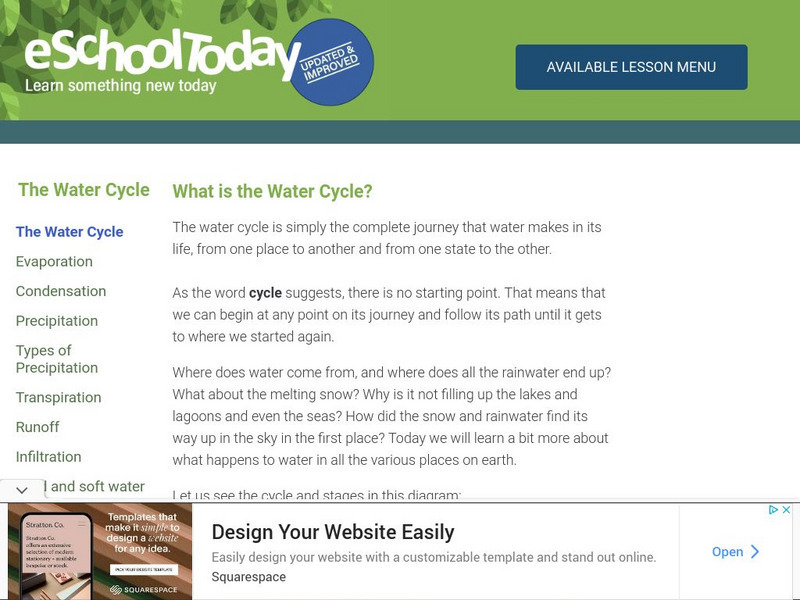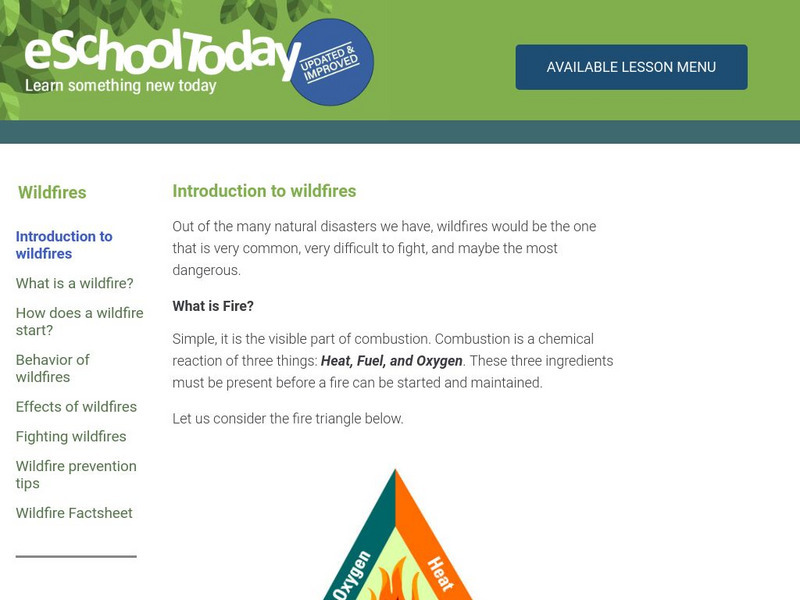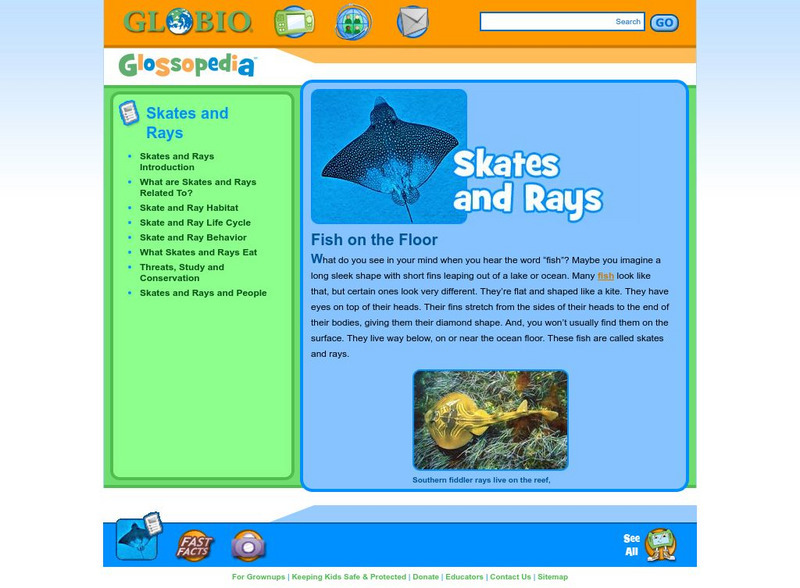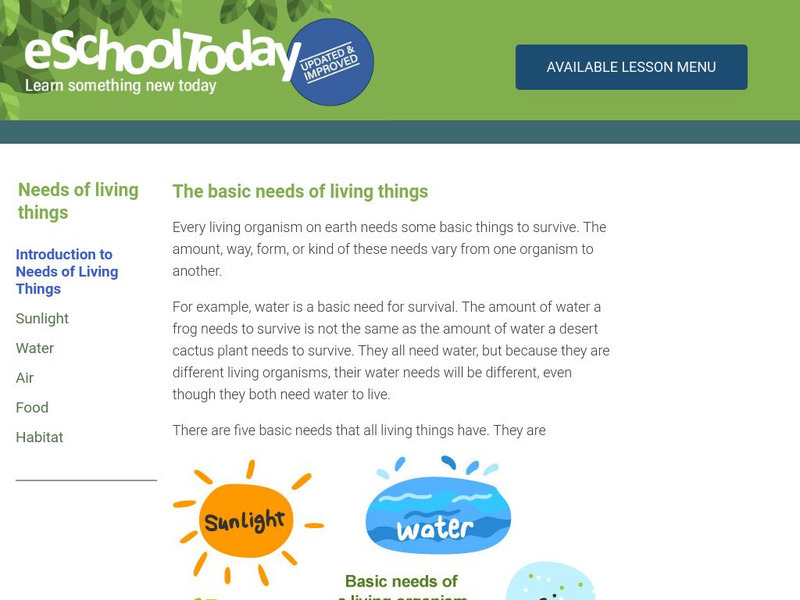eSchool Today
E School Today: Your Revision Notes on Rocks
Covers the three main types of rocks, different weathering processes, erosion, and the rock cycle.
eSchool Today
E School Today: Your Revision Notes on the Water Cycle
Learn about the different stages of the Earth's water cycle, and about processes involving water, including runoff, infiltration, and the differences between hard and soft water.
eSchool Today
E School Today: Your Revision Notes on the Nutrients in Food
Discusses food, why we need it, and the types of nutrients that food for humans must have.
eSchool Today
E School Today: Your Cool Basics on Natural Resources
Looks at the two categories of natural resources, what they are used for, their distribution around the world, threats to natural resources, recycling and composting, and conservation.
eSchool Today
E School Today: Your Cool Facts and Tips on Wildfires
Explains what a wildfire is, what causes them, how they behave, their impact, how to fight them, and how to prevent them.
eSchool Today
E School Today: Oral Care Tips for Great Teeth & Great Smiles
Learn about milk and adult teeth, the types of teeth we have and their functions, the anatomy of a tooth, dental decay and tooth plaque, how to take care of your teeth, what dental braces do, what causes bad breath or halitosis, and why...
Enchanted Learning
Enchanted Learning: Missouri
This site has a colorful display of information about Missouri. It contains a map, pictures, a list of state symbols, and links to related information.
Enchanted Learning
Enchanted Learning: Nebraska
This site has a colorful display of information about Nebraska. It contains a map, pictures, a list of state symbols, and links to related information.
Enchanted Learning
Enchanted Learning: Wyoming
A colorful display of information about Wyoming. Contains a map, pictures, a state symbols list, and links to related information.
Globio
Glossopedia: Stars
Many of the objects you can see in the night sky are stars, large objects in space that produce light. Our galaxy, the Milky Way, contains more than 100 billion stars. Stars are so far away that their light does not reach us for years....
Globio
Glossopedia: Skates and Rays
There are more than five hundred different species of skates and rays in our oceans. Scientists say that these fish are closely related to sharks, sharing a common ancestor from around 400 million years ago. This article provides an...
Globio
Glossopedia: Chocolate
Chocolate begins as a seed of the tropical cacao tree. It has been a prized taste sensation for more than 2,500 years. One reason chocolate is so nice to eat is that it melts just below body temperature. So it really does melt in your...
PBS
Pbs Learning Media: The Columbian Exchange
In this interactive lesson supporting literacy skills, students watch video dramatizations that tell the story of the Spanish explorers who arrived in the Americas with Columbus and introduced European, African, and Asian plants and...
Exploratorium
Exploratorium: Bubbularium
What colors do you see in a bubble? Why do you see colors in a bubble? Use this site to find out the answer to these questions with this easy experiment.
Exploratorium
Exploratorium: Outrageous Ooze
Students can make ooze and learn about different qualifications of matter. An easy procedure is provided to make gooey ooze that you can play with when you are done.
Exploratorium
Exploratorium: Salt Volcano
By making oil float on water--with the help of other ingredients--students can create a lava-lite effect.
Exploratorium
Exploratorium: Hoopster
Students create their own airplane using straws and other materials and learn the principles of aerodynamics.
Exploratorium
Exploratorium: Roto Copter
Students can experiment with a home-made helicopter that lets them change the blades to see how real aerodynamics work.
Library of Congress
Loc: Everyday Mysteries: Why Do Bats Live in Caves?
Ever wonder why bats live in caves? Or why bats don't fly into objects at night? This article describe why bats thrive in the protected shelter a cave provides. It also explains how bats use echolocation to locate food and avoid obstacles.
eSchool Today
E School Today: Your Revision Notes on the Needs of Living Things
Learn about the five things that all living things need to survive and why they are critical for both plants and animals.
eSchool Today
E School Today: Your Revision Notes on the Characteristics of Living Things
Discusses the five characteristics that living things have and nonliving things do not.
Colonial Williamsburg Foundation
The Colonial Williamsburg Foundation: Pardon or Pillory
Guess the letters in the words to save the colonist from the pillory. This play on hangman reviews historical vocabulary.
Scholastic
Scholastic: Global Trek: Mexico Questions and Answers
Students in Mexico answer questions about their lives, comparing their experiences to those of American children. They talk about popular names, celebrations, food, geography, social and environmental issues, the economy, history,...
University of Florida
Baldwin Library: Abridged History of the United States
A scanned copy of the 1852 publication of Abridged History of the United States by Emma Willard, a nonfiction book for children.

























